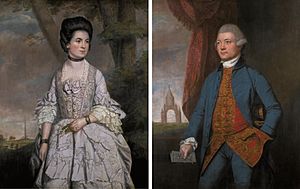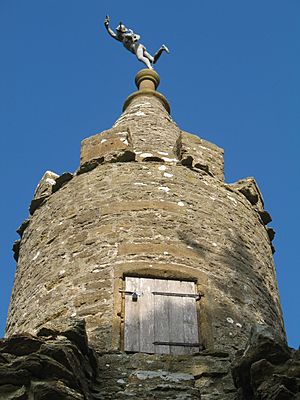Barwick, Somerset facts for kids
Quick facts for kids Barwick |
|
|---|---|
| Population | 1,221 (2011) |
| OS grid reference | ST564139 |
| District | |
| Shire county | |
| Region | |
| Country | England |
| Sovereign state | United Kingdom |
| Post town | YEOVIL |
| Postcode district | BA22 |
| Dialling code | 01935 |
| Police | Avon and Somerset |
| Fire | Devon and Somerset |
| Ambulance | South Western |
| EU Parliament | South West England |
| UK Parliament |
|
Barwick is a village and parish in Somerset, England. It is about 2 miles (3.2 km) south of Yeovil. The village is also close to the border with Dorset. The parish includes the village of Stoford and has about 1,221 people living there.
Contents
History of Barwick
The first signs of people living here are from the Bronze Age. In 1826, tools and other items from an ancient burial were found. This was near the village of Stoford. Stoford might get its name from old Saxon words meaning "Stow-Ford".
People may have lived in Barwick since Saxon times. The village was first mentioned in records in 1185. During the Middle Ages, Stoford was seen as a new town. A survey in 1273 showed 74 "burgages." These were special plots of land where people lived. Each one paid a small amount of money every year. The total number of people in Stoford in 1273 was likely over 500.
Stoford kept its special town status for at least 300 years. There was even a "guildhall" mentioned in 1361. This was a building for local groups or businesses. There was also a separate court for the town. Records from 1569 still talked about a "borough of Stoford." A borough is a town with its own special rights.
How Barwick is Governed
The parish council helps run local issues in Barwick. It decides how much local tax (called a precept) is needed. This money covers the council's costs. The council also checks plans for new buildings. It works with the police and local groups to keep the area safe. They also help with traffic issues.
The parish council starts projects to fix and care for village facilities. They also talk with the bigger local council. This is about roads, drainage, footpaths, public transport, and street cleaning. Looking after old buildings and the environment is also part of their job.
Since April 1, 2023, Barwick is part of Somerset Council. This is a single council that handles all local services. Before this, it was part of South Somerset.
Barwick is also part of the Yeovil area for the UK Parliament. This means people in Barwick vote for one Member of Parliament (MP). This MP represents them in the House of Commons in London.
Barwick Park Estate
The land for Barwick Park used to belong to a place called Syon Abbey. After the monasteries were closed in the 1530s, the land changed owners many times.
The house and park you see today were likely built around 1770. They were built by John and Grace Newman. Their relatives owned a nearby estate called Newton Surmaville.
The house had beautiful gardens with a lake and a grotto (a small cave-like structure). The park also had a Gothic style lodge and four interesting buildings called follies. In the early 1800s, the estate went to Thomas Messiter. He was John Newman's nephew. Around 1830, the main house was updated. It was changed to look like the old Jacobean Revival style. An orangery was also built. This was a special building for growing citrus trees.
During the early 1900s, different people rented the estate.
Barwick Park During World War II
During World War II, Barwick Park was used as a prisoner of war camp. At first, it held Italian prisoners. They were captured during fighting in North Africa. Later, it held German prisoners. These prisoners were captured after the D-Day landings in France.
After the war, the Messiter family moved back in. They made many updates and repairs to the house.
Later, the property became a school called Broadhembury College. This was in the 1960s. From the 1970s to the mid-1980s, the mansion was a private boarding school for boys. New classrooms, a swimming pool, and a gym were added. The school also had a Sea Cadet Corps group. The school closed around 1986 or 1987.
In the 1990s, a private owner bought the estate. They did a lot of work to fix up the house and the park buildings. The estate is still privately owned today.
Barwick Park Follies
Barwick Park is famous for its four follies. A folly is a building built to look interesting, but it doesn't have a normal use. Local stories say they were built in the 1820s. This was to give work to people on the estate when times were hard. George Messiter might have asked for them to mark the edges of the park.
The four follies are:
- Jack the Treacle Eater: This is a stone arch with a round tower on top. It is to the east.
- The Fish Tower: This is in the north.
- Messiter's Cone (also called the Rose Tower): This is about 75 feet (23 m) tall. It is at the west end.
- The Needle: This is to the south.
However, some paintings from the 1780s show two of the follies. This was 40 years earlier. The follies are so special that they were listed in "Britain's top 10 follies" by the TV show Countryfile in 2009.
Transport in Barwick
The parish has Yeovil Junction railway station. This station is on the main train line that goes between London and Exeter.
The Church of Saint Mary Magdalene
The Church of Saint Mary Magdalene is just off the A37 road. It is at the western end of the village. This is about half a mile from the main part of Barwick.
The church was built before 1219. It started as a small chapel for a bigger church in Yeovil. It has been rebuilt and fixed up many times since then. A big restoration happened in the 1850s. Church services are still held there every week.
The most important parts of the church are its bench ends. These are the carved ends of the wooden pews (benches). They are from 1533, just before the English Reformation. The carvings show scenes from village life. They also show old symbols like the Green Man and the unicorn. The unicorn was a symbol of eternal life. The church also has older religious items. For example, there is a Norman font. This is a stone basin used for baptisms.
The church is a Grade II* listed building. This means it is a very important historical building.
Sport in Barwick
A short-lived greyhound racing track opened in Barwick in 1931. It was at Barwick Field on Long Lane. This track was independent. It was not part of the main racing group. These independent tracks were sometimes called "flapping tracks." The races were 525 yards long. The racing stopped in early 1932.
Gallery
See also
 In Spanish: Barwick (Somerset) para niños
In Spanish: Barwick (Somerset) para niños








